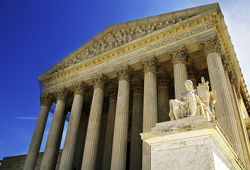 The transcript of today’s Supreme Court oral argument in Sandoz v. Amgen has been posted online and is available here.
The transcript of today’s Supreme Court oral argument in Sandoz v. Amgen has been posted online and is available here.
As we covered briefly this morning, the questioning during today’s argument focused primarily on three points.
On the 180-day notice issue:
1. Whether FDA can approve a biosimilar before a 12-year exclusivity period expires:
- Justice Breyer questioned whether the “notice” in subsection (l)(8) is notice “of the first commercial marketing of” a licensed biological product, or “notice that you will commercially market X,” or “some combination thereof,” and asked: considering this “ambiguity,” “why isn’t the way to go about this case to ask the agency to issue some regulations?” The need for additional agency guidance was a theme of Justice Breyer’s questioning.
2. Whether it would be possible for a reference product sponsor to file a complaint in good faith before FDA confirms the parameters of a final product licensure:
- Justice Sotomayor asked Sandoz’s lawyer whether a reference product sponsor could “file a declaratory judgment action when they don’t know what [the biosimilar applicant is] going to do”: “Do [reference product sponsors] have a good-faith basis for believing [the biosimilar applicant is] going to infringe if they don’t have the application to look at until they get discovery?”
On the patent dance and information disclosure issue:
3. Even if “shall” means “shall,” what is considered a “violation” of the statute, and what remedies are available? This issue is entangled in questions regarding the scope and nature of any remedies provided under federal law, and whether/how state law factors into this equation.
- The United States argued that “it would muck up the statute for courts to come in and start policing each step of the (l) dance.” The government’s lawyer also affirmed that FDA and the Patent and Trademark Office (PTO) share the position that their agencies do not regulate—and are separate from—the patent dispute resolution provisions of the BPCIA. He reaffirmed that FDA would not be doing a rulemaking on this subject, because in the government’s view, Congress answered these questions in the statute rather than delegating them to the agency.
- Justice Breyer noted he would find an explanation of the statute “far more convincing” if “there had been notice and comment [rulemaking] proceedings before an expert agency,” such as FDA.
- Justice Gorsuch raised a question of how the Court should consider the fact that Amgen in this case sought injunctive relief under state law, and that the parties have not appeared to argue that state law is preempted in this case: “So where does that leave us? (l)(9) might otherwise be the exclusive—or almost exclusive mechanism, but what happens when we have a claim under State law that no one’s argued is preempted?”
- Justice Gorsuch also posed the following to Amgen’s lawyer: “[I]t’s hard to divorce a right from its remedy…and to understand the contours of the right.” Justice Gorsuch asked: “[L]et’s say I spot you…that (2)(A) ‘shall’ means shall…[T]he question still remains under…(l)(9)(C), what the remedy is. And we’ve heard from the other side that the exclusive remedy is a declaratory judgment action. And how can we possibly decide what (2)(A) means without taking a peek at (9)(C) as to what remedies are permitted?”
- Chief Justice Roberts similarly questioned whether the statute “can function in the way [the government] is arguing, even if there are injunctions…[b]ased on State law provisions.” He noted: “[I]t seems to me that it’s very hard to give a comprehensive answer to the questions presented without considering whether, well, thanks for your opinion on what Federal law does, but, in fact, State law, you can get the same injunction. It’s really asking us to put together a puzzle where a big piece is missing.”
- In questioning posed to Amgen’s lawyer, Justice Sotomayor asked: “Under your reading, [(l)(9)] (B) and (C) become superfluous, because if you can get a State law information-exchange provision under (C) or…under State law, why give the remedy of starting a declaratory-judgment action at all?”
